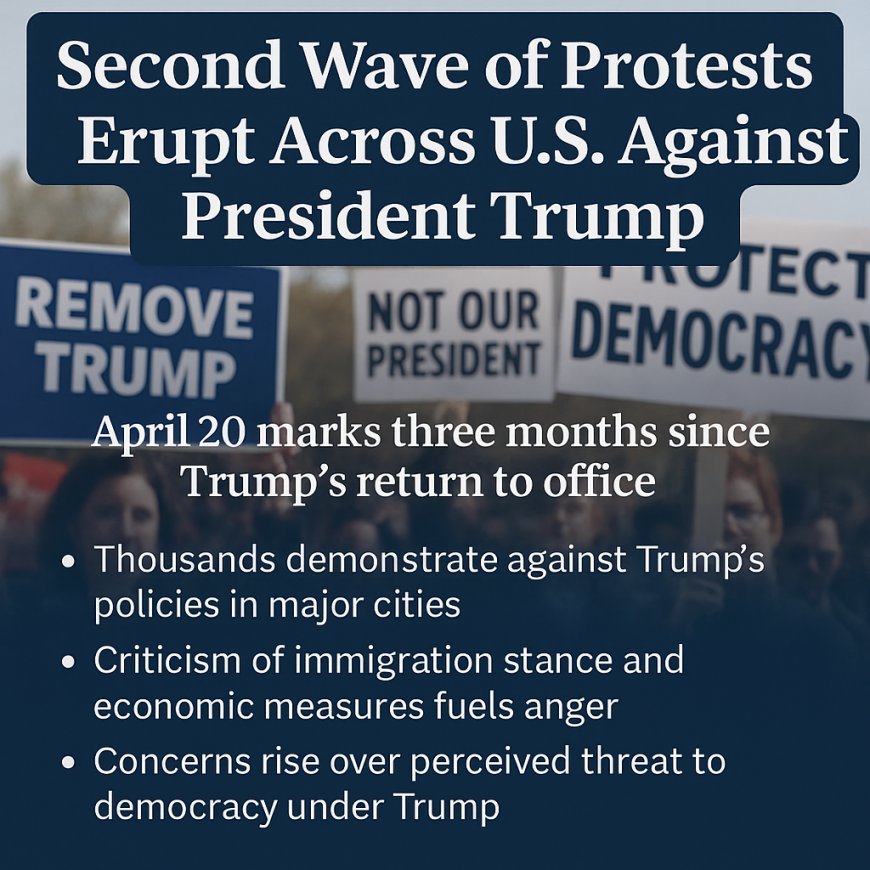Massive Protests Erupt Across the US Against Trump’s Policies Three Months Into His Return
Thousands protest against Donald Trump's administration across major US cities. Explore the causes, testimonies, and political impact of the second wave of protests.

The United States faces another weekend of widespread political unrest as thousands take to the streets to protest President Donald Trump's controversial policies. Exactly three months after his return to the White House, Americans across more than 60 cities rallied to express concerns over democratic erosion, harsh immigration measures, economic uncertainty, and administrative overreach.
Background: Trump's Return and Its Aftermath
Following a contentious and polarizing election, Donald Trump was sworn in again on January 20, 2025. His reentry into office reignited divisions nationwide, especially among progressive and moderate circles. Within his first 90 days, Trump has reinstated aggressive immigration policies, triggered economic instability through tariffs, and initiated deep cuts in the federal workforce.
The April 20 Protests: National Mobilization Amplified
On April 20, protests erupted across the country. Cities like Washington D.C., New York, San Francisco, Chicago, and Seattle witnessed marches, speeches, artistic performances, and vigils. Over 1.2 million people participated, surpassing the numbers from the first major protest on April 5.
Organizers and Key Cities
- Washington D.C.: Marches ended near the White House with chants of “Protect Democracy!”
- New York City: Union Square filled with activists, students, and families.
- Los Angeles: Civic Center rallies drew attention to immigration policy rollbacks.
Why Are Americans Protesting?
Protesters cited several core issues, all pointing toward fears of a growing authoritarian trend under Trump’s second presidency.
1. Strict Immigration Policy
Trump reinstated Title 42, reactivated border wall construction, and slashed refugee programs. These measures sparked outrage, especially in immigrant communities and sanctuary cities.
2. Economic Uncertainty and Tariff Policies
The President’s aggressive tariff strategy has destabilized markets. The U.S. dollar dropped sharply in April, while inflation fears and a looming recession stir anxiety across the middle class.
3. Federal Workforce Reductions
Massive layoffs in federal departments, including health, education, and environmental agencies, have alarmed citizens and public servants alike. These cuts are seen as weakening institutional resilience.
4. Concerns Over “Project 2025”
Dubbed a “blueprint for authoritarianism” by critics, Project 2025 outlines plans to expand presidential powers and dismantle key federal institutions. While unofficial, Trump allies have hinted at implementing parts of it.
Voices From the Streets: Protesters Speak Out
Protesters expressed deep emotional and political frustration:
“We’re losing the idea of America. It’s not just policies, it’s about our identity as a democratic nation,” said Rachel M., New York.
“If this continues, we won’t recognize our country in a year,” shared James L., Denver.
“I thought Trump’s talk was just bluster. Now I see it wasn’t. That’s why we’re here,” explained Karina T., San Francisco.
White House Reaction and Republican Division
The Trump administration downplayed the protests. “This is democracy at work,” said Press Secretary Laura Greene. Still, moderate Republicans voiced unease. Senator Mitt Romney warned of deepening national divides, while Congresswoman Liz Cheney stressed the danger of institutional weakening.
Media Coverage and Global Perspective
The protests dominated international headlines. BBC, Le Monde, DW, and Al Jazeera featured footage and interviews, portraying the protests as emblematic of democratic resistance. Analysts worldwide interpret the movement as a barometer of Western democratic health.
What Comes Next?
Short-Term Implications
- Pressure on Congress: Lawmakers may feel compelled to block or delay Trump initiatives.
- Progressive Movement Surge: Leaders like Alexandria Ocasio-Cortez gain momentum as voices of organized resistance.
- Potential for More Protests: Activist networks continue to organize, with a nationwide strike hinted for May.
Long-Term Political Impact
The protests could significantly influence the 2026 midterm elections, especially in battleground states. Trump’s approval ratings are already showing fluctuations in suburban and independent demographics.
A Nation at a Crossroads
The protests of April 20 mark a pivotal moment in America’s political history. As Trump’s presidency embarks on its fourth month, resistance grows louder and more coordinated. The coming months will test the durability of U.S. democratic institutions and the power of civic engagement.
Keywords: Trump protests April 2025, US demonstrations, Project 2025, democracy in danger, anti-Trump rallies, White House protest news
What's Your Reaction?
 Like
0
Like
0
 Dislike
0
Dislike
0
 Love
0
Love
0
 Funny
0
Funny
0
 Angry
0
Angry
0
 Sad
0
Sad
0
 Wow
0
Wow
0

































